On The Road, At Last: Katakolo & The Peloponnese

“The invitation jolted us out of our doldrums; we hardly had to think twice. We needed a change desperately, couldn’t face going to the island and spending days getting the house, empty for the past six months, habitable again; the friends we usually spend Easter with had other plans; and staying in Athens seemed a dismal prospect.”—Diana Farr Louis
Eating Well Is The Best Revenge
By Diana Farr Louis
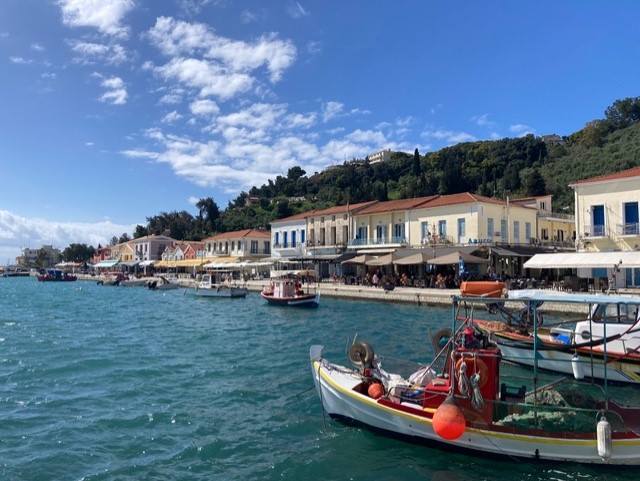
ATHENS Greece—(Hubris)—1 June 2023—Perhaps the best thing about this story is that it started with a response to the moan in my February contribution to “Hubris” which had to do with stifled wanderlust. A dear friend who lives on the other side of the US left a comment on my son’s Facebook page, where he’d shared it, telling me to look at my messages: “We will be in the Peloponnese for Easter, wanna come with?”
The invitation jolted us out of our doldrums; we hardly had to think twice. We needed a change desperately, couldn’t face going to the island (Andros) and spending days getting the house, empty for the past six months, habitable again; the friends we usually spend Easter with had other plans; and staying in Athens seemed a dismal prospect.
A flurry of messages and phone calls ensued and lo, the hotels were booked, and we would meet on 13 April at a taverna next to the submersible bridge across the entrance to the Corinth Canal.
The start to our adventure was not auspicious. The charming taverna we remembered was abandoned and a tourist bus brimming with loud Americans preceded us by a couple of minutes at the open eatery on the other side, bagging all the waterside tables. But we made the best of it, happy to be reunited, and Gus was ecstatic to be eating the first of many Greek salads: “Tomatoes in the US have NO taste!”
As predicted, the traffic was heavy on that Thursday before Easter, but we never had to slow down to a crawl and made our way west on the highway to Patras, for the first time since its decades-long expansion was finally completed, and then on towards Pyrgos and our ultimate destination, Katakolo.
Why Katakolo? We did wonder, especially since our old Greek guidebook (printed in 1998) says, “Katakolo presents a miserable picture, both the town and the port. If only the old currant warehouses had been refurbished . . . now it is the equivalent of a Greek pizzeria, plastic chairs, and colored awnings.” Happily, it was not so dismal. Most of the warehouses (from the days when currants were Greece’s black gold)—two-story buildings with pointed roofs—have been painted bright colors (yellow, pink, white, blue) and turned into attractive cafés and restaurants, while the two inner streets were lined with pretty shops hoping to attract cruise-boat passengers, who are usually whisked off to nearby Olympia before they have a chance to explore.
But the real reason our friends chose Katakolo is because they have become friends with the owner of its best hotel, Orizontes View, Stephanos Giakoumelos, a former sea captain, currently tugboat pilot for those cruise ships. He endeared himself to us, too, as we exchanged stories about Andros sea captains and native-son shipowner/philanthropist Yiannis Latsis, for whom the port is named. He also went out of his way to find us a place where we could eat our Easter lamb, all restaurants in Katakolo being shut on Easter Sunday.
Before that, though, we feasted on the scenery, the 50 shades of green—umbrella pines, plane trees, oaks, monkey puzzles, cypress, olives, grasses—interrupted by bursts of flamingo-pink judas trees, cascades of pale blue wisteria, and yellow mimosas, daisies, and sweet-smelling broom. Balm for the soul after the already parched roadsides of Attica. And a revelation. We had not been in this part of Greece in so long we had forgotten it was so lush. Granted, it was not all gorgeous. This being the strawberry capital of the country, many of the fields were white with row upon row of low plastic tunnels protecting the young plants from bad weather and bugs. And we tried not to dwell on where all that plastic would end up.
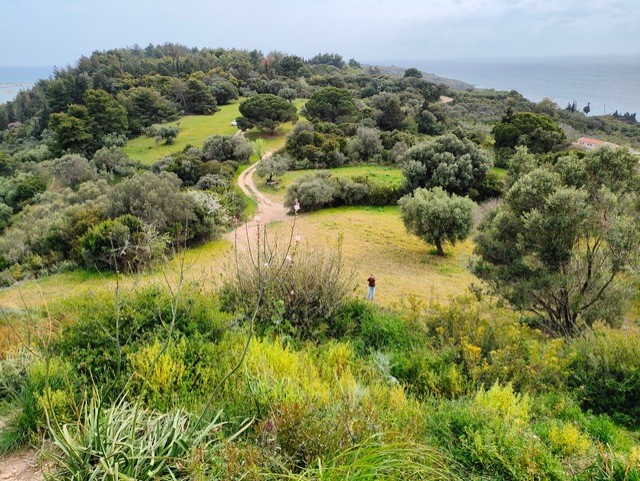
Instead, we played at being tourists, our first stop the stunning museum at Olympia with its astonishing range of exhibits from 8th-century BC bronze griffins to the famous frieze depicting the battle between Centaurs and Lapiths (rivaling the Parthenon marbles) and Praxiteles’ Hermes to the rather coarse by comparison Roman-era statues with their overly decorated robes, shields, and tunics.
Second stop, a lengthy lunch in a nearby café/restaurant, which was surprisingly good despite catering mostly for “furriners.” Third stop that Friday: a walk near the hotel to the overgrown ruins of Pontikokastro (Mouse Castle) and the wetlands below it, where we were greeted by a raucous chorus of a myriad frogs. We had a nice fishy dinner that evening in an empty restaurant—everyone else was paying their respects to the Good Friday church service and procession that follows it, led by pall bearers carrying the “bier of Christ.” Usually slow and solemn, this one sped past us so quickly we didn’t even catch a glimpse of it.
Saturday we’d set aside for a pilgrimage to Greece’s best preserved Crusader castle at Chlemoutsi, where I had last been in 1973 or 74, inspired by Kevin Andrews’ wonderful book, Castles of the Morea. I’ve always been fascinated by that brief period when knighthood was in flower in Greece, after the perfidious Venetians sailed to Constantinople instead of Jerusalem in 1204, toppled the Byzantine emperor and took over the Greek islands and mainland for a few centuries until the Ottomans gradually took their place. Getting there was somewhat tortuous due to narrow streets that should have been one-way and the lack of signs, but well worth it since the castle was finally visitable, so different from most Greek ruins, and a reminder that the builders of these improbably thick, high walls, arches, and ramparts were of the same era as those who built Notre Dame, Chartres, Rheims, and other cathedrals in Western Europe.
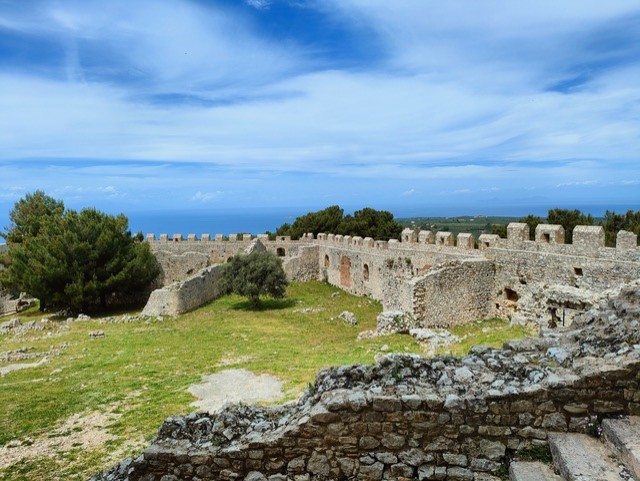
On Saturday night, we did not keep with tradition and eat soup made of lamb’s innards, but we did watch an orgy of fireworks from our terrace well above town as well as from about seven other spots down the long, long coast that finally ends at Pylos. Our Easter Sunday did not measure up to parties and spit-roasted lamb on Andros, but that was to be expected and we remained happy to leave the fuss and bother to others and take long pre- and post-prandial walks on two different beaches.
Then, back to our cars in the morning for the drive down the coast to Pylos, via Kyparissia, a charming little port whose houses seemed to rise almost perpendicular to the sea, with an “old upper town, great castle, ruins of an Ottoman hammam, and cocktails with a view, plus galaktoboureko to die for,” according to a friend who has a house in the area. Unfortunately, the castle was shut, and it was noonish, so we contented ourselves with a simple but delicious lunch on local specialties at Palia Agora. We missed the shops she’d described but also the falls and pools at Nemouta, which would have required a small detour and perhaps a better car or stronger legs.
And Pylos beckoned, with its historic, circular Navarino Bay, wetlands, and associations with Homer’s Nestor. Of course, the town was crowded, but our hotel perched near the Ottoman castle, on a dead end above the water and with a great view of the bay, town, and island of Sphakteria, where Spartan soldiers were besieged for months and finally surrendered to the Athenians in 425 BC (instead of dying on their shields). It is of course here that Greece’s independence was clinched, by accident, in 1827, when the assembled navies of England, France, and Russia demanded the surrender of the Turkish-Egyptian fleet. Ibrahim Pasha refused, and a few shots fired by a Turkish sailor or two triggered a massive reprisal by the Allied cannons, which demolished the Ottoman fleet. The war would drag on until 1830 but, after Navarino, there was never any question that (a large part of) Greece would one day be free.
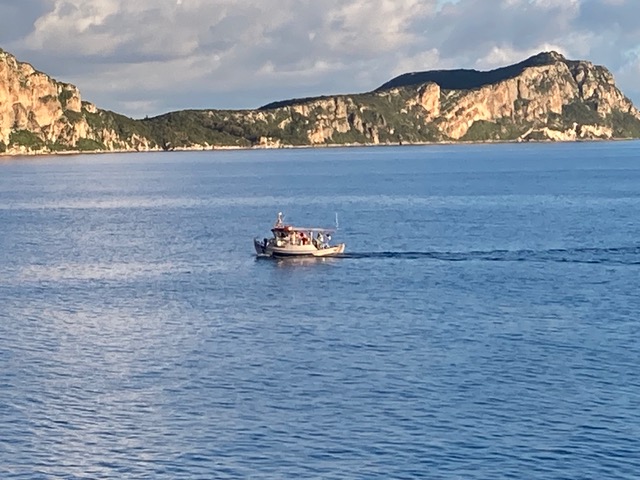
But we hardly bothered with these relatively modern events and instead made a pilgrimage to Nestor’s Palace (c. 1400 BC), which was a huge disappointment. When all of us first saw it, back in the 1970s, many of the finds were still in situ. I particularly remember the pantry, with its huge platters, goblets, bowls, cooking pots, and amphorae—that allowed us to imagine Nestor’s welcome of Telemachos, when he came in search of his father, Odysseus. Now the once two-story palace is just a covered space with a few humps and hollows indicating water conduits, column pedestals, and hearths, with nary a photo to show what it had been like. And the finds? In a museum in a nearby village that closed for renovation three years ago and is scheduled to reopen three years from now.
We felt obliged to stroll around the elevated walkway and then hopped back in the cars to head for two more castle towns. Koroni and Methoni, on the east and west tip of the first “finger” of the Peloponnese, were once known as “the eyes of Venice,” built to track trade and armadas when La Serenissima ruled the Eastern Mediterranean. They were of sentimental interest, too, since our traveling companions had met in Methoni a hundred years ago when they were both working for legendary underwater archaeologist, Peter Throckmorton, and went on to captain his boat, Stormie Seas, for several years.
And my husband always likes to claim his relationship to his mother’s grandfather, Demetrios Tringetas, the Barba or Uncle of Koroni. Although he was a politician, elected several times in the 1860s and 70s as MP from the area and served four times as Minister of the Army—which would have given him ample opportunity to hand out favors and jobs as the phrase implies—Wikipedia actually gives that title to either a former mayor or a former pasha. Never mind, it’s more fun to have a dubious ancestor; it’s our story and we’re sticking to it.
Here too, we only touched the surface of both castles and towns, having a delicious lunch in the strangely named Parthenon Restaurant on the Koroni waterfront, a short ramble in part of the castle grounds, a walk on the beach next to Methoni Castle, and drives through spectacular scenery, which included a whole mountainside tinted red by a zillion tiny flowers.
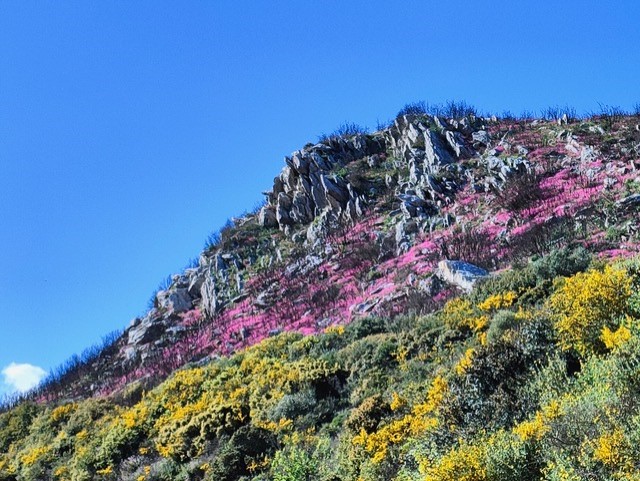
On our last day, I thought it would be fun to show Pam and Gus the Costa Navarino hotel complex, touted by National Geographic as one of the world’s best travel experiences. I had stayed there ten years ago but, alas, the gate keepers were most unfriendly and would not let us enter the premises unless we were meeting guests. Costa Navarino, therefore, lost forever some potential customers, leaving a sour taste in our farewell.
We traveled back to Athens via one of our favorite sites, Ancient Messene, a magical place of which no trace existed in the early 1970s, and which now hosts festivals and is not yet fully excavated. A glorified golf cart driven by an enthusiastic Costas enabled even the non-walkers to see all the mosaics, the stadium, theater, and altars, plus a small olive grove, still privately owned since its owner will not be bought off. Costas refused a tip and said that he used to work for the Greek railroad company. “But the trains stopped in 2010, I got a job here at the site, and it changed my life.”
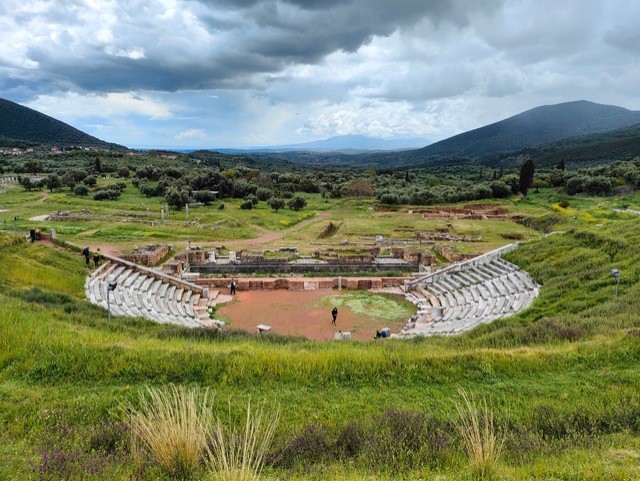
Back in Athens, recollecting in tranquility, we talk of the meals we had, the people we met, the beauty of the towns and countryside. But most of all, we remember the joy and ease of being with our friends of more than 50 years, their thoughtfulness and stories, and we thank them for gently lifting us out of our rut and reminding us of the pleasures of travel. We are already planning the next trip, back to Pylos—we hope with Pam and Gus—to explore the things we missed, the waterfalls and pools, the interiors of castles, the wetlands, forests, and beaches, and to share good food, good wine, and good talk.
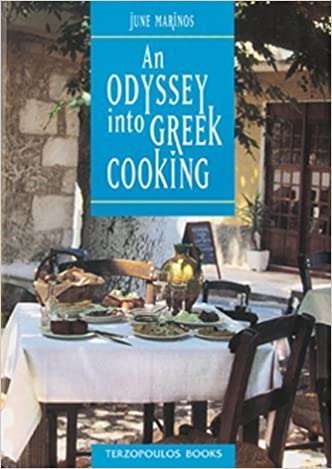
Recipe
Smoked Trout Mousse Loredana
This has nothing to do with the Peloponnese, but I am in the mood for smoked trout, and this popped out of a book written by my dear friend and colleague, June Marinos, who passed away a year ago and whose birthday was also in June. I have no idea what Loredana means, but here it is, slightly amended, from June’s An Odyssey into Greek Cooking.
Ingredients:
250 g/8 oz smoked trout, lightly mashed
1 tbsp powdered gelatin
4 tbsp cold water
2 cups fresh cream
3/4 cup mayonnaise
1 small onion, very finely grated
2 tbsp very finely chopped parsley
at least 2 tbsp lemon juice
Salt and, because I like it, freshly ground black pepper
And optional, for a little oomph, because it needed a little oomph, a tablespoon of wasabi or horseradish, to taste
Sprinkle the gelatin on top of the cold water and leave for five minutes.
Put 4 tbsp of the cream in a small saucepan, add the gelatin and water, and heat until the gelatin is dissolved. Set the mixture aside to cool slightly.
In a bowl, beat the remaining cream until fairly stiff. Stir in the gelatin mixture, then add the remaining ingredients. Season with salt and pepper to taste.
Pour into an oiled ring mold and refrigerate for at least 12 hours.
Turn out the mousse and decorate it with parsley, slices of lemon and ripe olives. Fill the center with finely shredded lettuce.
Yields multiple servings as an appetizer.
![]()
To order the paperback book, click on the book cover below:

